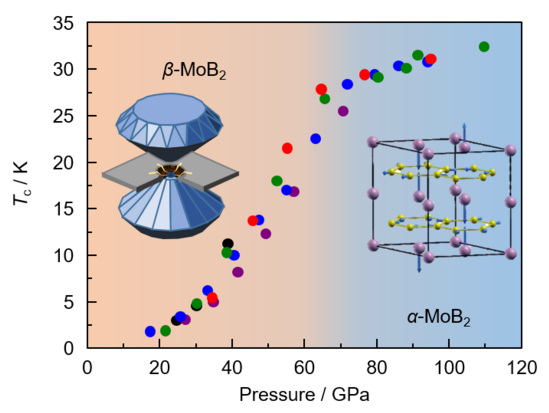Due to their considerable scientific and practical benefits, high-Tc superconductors (high-Tc SCs) have been a long-sought objective in the condensed matter physics and materials science.
 The superconducting phase diagram of MoB2 as a function of the pressure is summarized in the Figure. Utilizing Diamond Anvil Cell (DAC) (left), it can be seen that the superconducting state emerges around 20 GPa, and then the Tc increases further with applied pressure, and beyond the structure-transition pressure (Pc ∼ 70 GPa) the growth of Tc slows down. The Tc of MoB2 rises to as high as ∼32 K at a pressure of 109.7 GPa and still does not exhibit the trend of saturation. Further theoretical calculations suggest that the out-of-plane phonon mode of Mo atoms couples strongly with Mo d electrons near EF (right). These results reveal the study of superconducting mechanism in high-pressure α-MoB2 sheds light on exploring of new phonon-mediated high-Tc superconductors in transition metal borides. Image Credit: Science China Press
The superconducting phase diagram of MoB2 as a function of the pressure is summarized in the Figure. Utilizing Diamond Anvil Cell (DAC) (left), it can be seen that the superconducting state emerges around 20 GPa, and then the Tc increases further with applied pressure, and beyond the structure-transition pressure (Pc ∼ 70 GPa) the growth of Tc slows down. The Tc of MoB2 rises to as high as ∼32 K at a pressure of 109.7 GPa and still does not exhibit the trend of saturation. Further theoretical calculations suggest that the out-of-plane phonon mode of Mo atoms couples strongly with Mo d electrons near EF (right). These results reveal the study of superconducting mechanism in high-pressure α-MoB2 sheds light on exploring of new phonon-mediated high-Tc superconductors in transition metal borides. Image Credit: Science China Press
Since mercury’s superconductivity was discovered over a century ago, only a few systems have Tc values higher than 30 K.
Now, superconductivity up to 32 K in MoB2 under pressure—the highest Tc in transition-metal borides to date—was found by researchers at ShanghaiTech University and their colleagues at the Renmin University of China.
Their research provides insight into the investigation of high-Tc superconductors in transition metal borides and was published online on February 14th, 2023 in the journal National Science Review.
Since it is the only material in the MB2 family to have both an α-MoB2 phase (AlB2-type) and a β-MoB2 phase (CaSi2-type) structural shape, molybdenum diboride (MoB2) is special. At around 65 GPa, β-MoB2 changes to α-MoB2, which has the same crystal structure as MgB2, according to synchrotron X-Ray diffraction (XRD) observations.
A question arises naturally: is it possible to achieve superconductivity in MoB2 under high pressure. So, we carried out the in-situ high pressure electrical transport measurements. Superconductivity is observed at 21.7 GPa and Tc increases with pressure.
Dr. Yanpeng Qi, Study Corresponding Author and Assistant Professor, School of Physical Science and Technology, ShanghaiTech University
Dr. Qi continues, "Beyond the critical pressure (Pc = 70 GPa) where the structural phase transition, the growth of Tc slows down and the maximum Tc of 32.4 K is attained at P = 109.7 GPa, which is the highest pressure we exert on the sample."
Despite the compressed MoB2 having a similar structure to MgB2 and a comparable Tc, additional theoretical calculations indicate that the former’s superconducting mechanism is entirely distinct from that of the latter: in contrast to MgB2, where the p-electrons and phonon modes of B atoms predominate, the d-electrons and phonon modes of the transition metal Mo atoms play a major role in superconductivity.
The findings of this study emphasize the hitherto underappreciated functions of transitional metals in borides’ superconductivity.
Given the synergistic effects of light elements with high-frequency phonon modes and strongly correlated electrons in transition metals, their discovery of MoB2’s superconductivity at a rather high Tc could also shed light on the exploration of high-Tc superconductivity in systems with light elements.
The Beijing Natural Science Foundation, the National Natural Science Foundation of China, the CAS Interdisciplinary Innovation Team, the National Key R&D Program of China, the Fundamental Research Funds for the Central Universities, and the Research Funds of the Renmin University of China generously supported this work.
Journal Reference:
Pei, C., et al. (2023) Pressure-induced Superconductivity at 32 K in MoB2. National Science Review. doi:10.1093/nsr/nwad034.